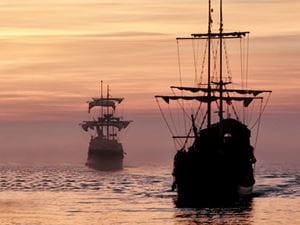
On August of 1492, Italian explorer Christopher Columbus set sail on his flagship, Santa Maria, on a exploratory mission to chart a new western sea route to the lands of South and Southeast Asia, but along the way, he just so happened to stumble upon the continent which would later be named America. The rest, as they say, is history.
Except, in the case of Christopher Columbus, “history” is lying to you.
Here’s the reality. Columbus didn’t set out to explore. He set out to make a buck. And he succeeded in ways which now make many shudder.
Columbus was obsessed with the idea of discovering a new trade route to potentially lucrative Asian territories. But there existed a huge obstacle to this goal—namely, the hostile Ottoman Empire, which blocked most of the known land and sea routes to Southern Asia.
Instead of trying to trek through hostile territory, Columbus came up with an idea: why not just sail westward around the globe until he made it all the way around, ending up in Asia?
But Columbus made two mistakes here. The first is that he grossly underestimated the western distance between Spain and Asia. The second is that he assumed that he would encounter no landmasses along the way.
On October 12th, one of Columbus’ men sighted what was thought to be Asian land, coming ashore not in what we know as North America, but in the Bahamas. In the ensuing weeks, he sighted Cuba, thinking it was mainland China, and Hispaniola, which he took to be Japan. He never did set foot on American soil.
Up to this point, we can understand Columbus. He was a businessman looking for a new trade route. But what he did next is where the popular narrative of Christopher Columbus truly diverges from reality.
Rather than exploring this new country, communicating with its native peoples, and establishing diplomatic ties, he did something reprehensible. To find out what, let’s look to one of his journal entries.
“As soon as I arrived in the Indies, on the first Island which I found, I took some of the natives by force in order that they might learn and might give me information of whatever there is in these parts.”
But that’s not all. He went on to write that the Natives “were well-built, with good bodies and handsome features. They do not bear arms, and do not know them, for I showed them a sword, they took it by the edge and cut themselves out of ignorance. They have no iron. Their spears are made of cane. They would make fine servants. With fifty men we could subjugate them all and make them do whatever we want.”
Columbus’ men tested the sharpness of their blades on the Natives, murdered both adults and children, using them as a source of food for their dogs, and helped themselves to Native women.
All of this is plainly outlined in Columbus’ own hand, and in those of his compatriots.
Such was the brutality of Columbus and his men that one witness wrote that “Such inhumanities and barbarisms were committed in my sight as no age can parallel. My eyes have seen these acts so foreign to human nature that now I tremble as I write.”
Columbus returned to Spain with news of a vast realm of potential slaves, vast veins of gold, and miles of fertile, agricultural land, and was awarded 17 ships, the title of “admiral of the ocean sea,” and was given over a thousand men to continue his expeditions.
To make good on these exorbitant promises, Columbus forced large numbers of Natives into slavery, setting them to work in gold mines, removing the hands of those unlucky enough to not produce enough gold per month.
Within a few short years, Columbus’ efforts killed or enslaved roughly a third of the 300,000 Natives on the island of Hispaniola.
Columbus gladly traded blood for this gold. In his final years, he revealed the naked framework of his worldview, writing that “Gold is the most precious of all commodities; gold constitutes treasure, and he who possesses it has all he needs in the world, as also the means of rescuing souls from purgatory, and restoring them to the enjoyment of paradise.” And, indeed—Columbus’ exploits helped make Spain one of the wealthiest nations on earth.
This is what we celebrate on Columbus Day.
The first celebration of his holiday came in 1792, when New York’s Columbian Order, as well as Italian and Catholic communities who took pride in Columbus’ birthplace and faith, commemorated the 300th anniversary of his landing.
It wasn’t until 1937, though, that President Franklin D. Roosevelt proclaimed it a national holiday, which came as a result of intense lobbying by the Knights of Columbus, a Catholic fraternal service organization named in honor of Christopher Columbus.
Although the majority of Americans admire Columbus, and support celebrating his life in the form of an official holiday, opposition exists. Most notably, Native American groups have regularly protested Columbus Day—a holiday celebrating an event which cost their ancestors their dignity, freedom, and lives.
Some U.S. cities and states have abandoned the holiday altogether. Los Angeles, for example, recently replaced Columbus Day with Indigenous Peoples Day, taking a cue from the city of Berkley, which did the same 25 years prior.
The debate about the American celebration of Columbus Day is a loud one. Should we continue to venerate a man’s accomplishments when they’re steeped in blood and lies? Should we ignore his morality in favor of his discoveries? Are those discoveries valid when the Americas were already “discovered” by their native inhabitants?
These are big questions. But however you decide to spend the 12th day of October, it shouldn’t be a decision based upon the desire to be “right.” It should be based on the desire to be truthful. Recognize Columbus’ misdeeds, even as you recognize his importance in the overall narrative of America.
We are a country woven of darkness and light, and in recognizing our own darkness, we can avoid repeating it. We can avoid condoning it. And most of all, we can avoid unknowingly justifying and celebrating an event that caused the suffering of untold numbers of human beings.

